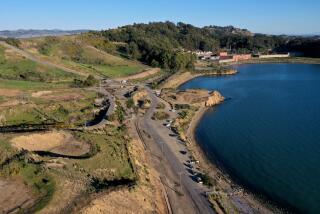Opposition Builds to Morro Bay Power Plant
- Share via
MORRO BAY — They tower over the shoreline as prominently as the town’s defining landmark, Morro Rock. The three power plant exhaust stacks have jutted 450 feet above the coast since 1954.
For many residents, the hum of the plant’s generators is as natural as the crashing surf or the stream of cars flowing along California 1. So plans by Duke Energy Corp. to replace the plant with a new one might be expected to move ahead smoothly, like the surfers who ride its hot water discharge out to the breaking waves.
But the construction plans have set off a grass-roots environmental movement in this placid resort and retirement town in San Luis Obispo County.
Residents have placed an initiative on Tuesday’s ballot to require a public vote before the plant can be expanded or replaced. Backers of the measure say mandating voter approval will prompt the town’s 10,000 residents to more closely scrutinize the plant, which many take for granted.
“We’ve lived with the plant so long that people just accepted it and thought it would always be there, because nobody had ever really talked about its impact,” said Jack McCurdy, who supports Measure Q and is vice president of the Coastal Alliance on Plant Expansion, a group founded to study the plant’s environmental impact.
McCurdy said the fact that 1,200 residents--nearly twice the required number--signed the petition to place Measure Q on the ballot reflects a new willingness to take a critical look at the plant.
The Morro Bay movement comes at a time, however, when other cities are favoring power plant construction, after a summer electricity shortage that doubled some customer bills in San Diego and south Orange counties. California now consumes 20% more power than it produces.
If approved by state utility regulators, the new plant would produce up to 1,300 megawatts of electricity, up from its current capacity of 1,030 megawatts. Duke officials said the company will spend $600 million on the project.
Henriette Groot, Coastal Alliance’s president, said she and others suspect that the plant is already damaging fish and wild bird populations, and should be further studied before an expansion is approved. “The Duke plans are really bothering us from an environmental point of view. We need many more facts before a decision can be made,” Groot said.
So far, the Morro Bay City Council has favored Duke’s expansion plans, approving a nonbinding memorandum of understanding in February in support of the project. Morro Bay Mayor Rodger Anderson and David Elliot, a city councilman, wrote the ballot statement against Measure Q. They argue that state authorities would have the power to override a vote by city residents anyway.
Measure Q is one of two ballot measures pertaining to the plant. The other, Measure P, is an advisory measure that asks residents whether the City Council should support the plant project.
Duke has also generated support for its project by arguing that it will be an environmental improvement. Duke plans to shut the existing plant and replace it with a cleaner, more efficient facility. The new units would be running by 2003. Duke officials say that in addition to being more fuel-efficient--and thus more profitable--air emissions will be cut 40%.
“It’s good for our business and good for the environment,” said Steven Goschke, Duke’s plant manager at Morro Bay.
Perhaps as important, the new plant will use exhaust stacks about a third as tall as the current ones, which will be razed by 2007, according to Duke’s plan. The shorter stacks would block less of Morro Bay’s scenic views, a point Duke officials have underscored by placing green bands around the existing stacks at 146 feet, the proposed stack height.
But members of the Coastal Alliance and Morro Bay Neighbors, the political group backing Measure Q, argue that residents should look beyond comparing the current plant to the proposed facility. Don Boatman, a Coastal Alliance member who works as a power plant consultant, says the city or a citizens group could buy the plant, run it long enough to finance the purchase, then shut it down.
The state’s power needs, Boatman said, can be met by plants already approved for construction elsewhere.
Duke officials have dismissed such a purchase plan, saying the plant is not for sale. But Boatman said that if public opinion in Morro Bay turns against the plant, that could change. The city could deny land use variances for the plant, Boatman said, or it could refuse to renew Duke’s 50-year lease on the site, which expires in 2004. “If the lease isn’t renewed, the plant will be for sale,” Boatman said.
Without a lease renewal, Duke could sue to continue to operate the plant. Duke spokesman Tom Williams said the company believes that the plant project doesn’t need land use variances because it falls within current requirements.
The plant, Williams said, will remain part of the Morro Bay landscape regardless of the expansion. “One alternative for us is to leave it,” because the current plant is profitable. “We can continue to run it as it is. It’s still viable and will be for years,” he said.
More to Read
Sign up for Essential California
The most important California stories and recommendations in your inbox every morning.
You may occasionally receive promotional content from the Los Angeles Times.













